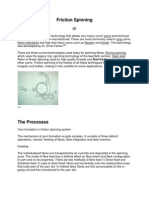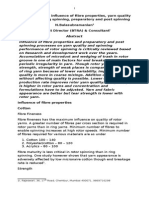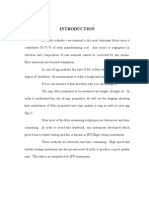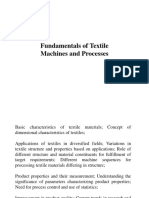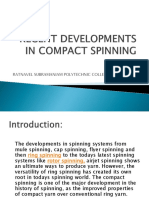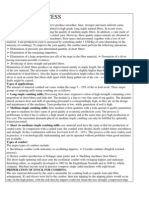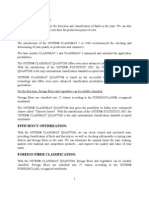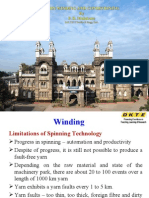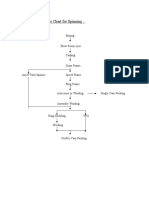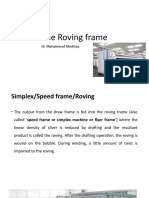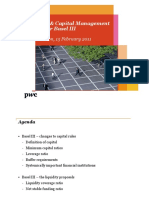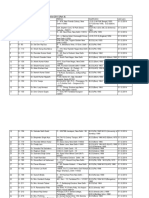Process Parameter in Blow Room
Process Parameter in Blow Room
Uploaded by
akmaluzirCopyright:
Available Formats
Process Parameter in Blow Room
Process Parameter in Blow Room
Uploaded by
akmaluzirCopyright
Available Formats
Share this document
Did you find this document useful?
Is this content inappropriate?
Copyright:
Available Formats
Process Parameter in Blow Room
Process Parameter in Blow Room
Uploaded by
akmaluzirCopyright:
Available Formats
PROCESS PARAMETER IN BLOW ROOM With all harvesting methods, however, the cotton seed, together with the
fibers, always gets into the ginning plant where it is broken up into trash and seed-coat fragments. This means that ginned cotton is always contaminated with trash and dust particles and that an intensive cleaning is only possible in the spinning mill. Nep content increases drastically with mechanical harvesting, ginning and subsequent cleaning process. The reduction of the trash content which is necessary for improving cotton grade and apperance unfortunately results in a higher nep content level. The basic purpose of Blow room is to supply
small fibre tufts clean fibre tufts homogeneously blended tufts if more than one variety of fibre is used
to carding machine without increasing fibre rupture, fibre neps , broken seed particles and without removing more good fibres. The above is achieved by the following processes in the blowroom
1.
Pre opening
2. 3. 4. 5.
pre cleaning mixing or blending fine opening dedusting
CLEANING EFFICIENCY: Cleaning efficiency of the machine is the ratio of the trash removed by the machine to that of total trash fed to the machine, expressed as percentage Cleaning efficieny % =(( trash in feed % - trash in del %) x 100) / (trash in feed %)
Following are the basic parameters to be considered in Blowroom process.
no of opening machines type of beater type of beating Beater speed setting between feed roller and beater production rate of individual machine production rate of the entire line thickness of the feed web density of the feed web fibre micronaire size of the flocks in the feed type of clothing of the beater point density of clothing type of grid and grid settings air flow through the grid position of the machine in the sequence
amount of trash in the material type of trash in the material temp and relative humidity in the blow room department
PREOPENING:
Effective preopening results in smaller tuft sizes, thus creating a large surface area for easy and efficient removal of trash particles by the fine openers.
If MBO (Rieter) or BOW ( Trutzschler) type of machine is used as a first machine
the tuft size in the mixing should be as small as possible. Normally it should be less than 10 grams
since this machine does not take care of long term blending, mixing should be done properly to maintain the homogenous blending
the inclined lattice speed and the setting between inclined lattice and clearer roller decides the production of the machine
the setting between inclined lattice and clearer roller decides the quality of the tuft
if the setting is too close, the tuft size will be small, but the neps in the cotton will be increased due to repeated action of the inclined lattice pins on cotton.
the clearance should be decided first to confirm the quality, then inclined lattice speed can be decided according to the production required
the setting of inclined lattice depends upon the fibre density, fibre micronaire and the tuft size fed. If smaller tuft is fed to the feeding conveyor, the fibre tufts will not be recycled many times, hence the neps will be less.
if the machine is with beater, it is advisable to use only disc type beater. Saw tooth and Pinned beaters should not be used in this machine, becasue the fibre damage at this stage will be very high and heavier trash particles will be broken in to small pieces.
the beater speed should be around 500 to 800 rpm depending upon the rawmaterial. Coarser the fibre, higher the speed
the setting between feed roller to beater should be around 4 to 7 mm
this machine is not meant to remove trash , hence the fibre loss should also be less
trash removal in this machine will result in breaking the seeds, which is very difficult to remove
It is easier to remove the bigger trash than the smaller trash, therefore enough care should be taken to avoid breaking the trash particles
this machine is just to open the tufts into small sizes so that cleaning becomes easier in the next machines.
the fibre tuft size from this machine should be preferably around 100 to 200 milligrams.
If tuft size is small, removing trash particles becomes easier , because of large surface area
If Uniflco11(Rieter) or Blendomat BDT 019(Trutzschler) is used as a first machine
It helps to maintain the homogeneity of the long term blending
cotton is opened gently without recyling as it is done in manual bale openers
with the latest automatic bale opening machines, the tuft size can be as small as 50 to 100 grams without rupturing the fibres
the opening roller speed should be around 1500 to 1800 rpm.
the depth of penetration of the opening should be as minimum as possible for better quality
It is better to use this machine with one mixing or maximum two mixing at the same.
If the production per feeding machine is less than 150 kgs, then four mixings can be recommended
production rate of this machine depends upon the no of mixings working at the same time
production rate depends upon opening roller depth, traverse speed and the fibre tuft density
in general , the machine parameters should be set in such a way that maximum number of take-off points are available per unit time.
with the latest machines (Rieter -Unifloc A11), around 60% of take-off points are more compared to earlier machines
PRECLEANING: Precleaning should be gentle. Since removing finer trash particles is difficult , seeds and bigger trash particles should not be broken. Finer trash particles require severe treatment in Fine openers. This will lead to fibre damage and more nep generation. Therefore, precleaning should be as gentle as possible and no compromise on this. If preopening and precleaning are done properly, consistency in trash removal by fine openers is assured. Dust removal should be started in this machine. Enough care should be taken remove dust in this process.
Rieter's Uniclean B11 and Trutzschler's Axiflow or Maxiflow are the machines which does this work
the fibre treatment in this machine is very gentle because the fibres are not gripped by the feed roller during beating. Fibre tufts treated by the pin beater when it is carried by air medium
all heavy trash particles fall down before it is broken
cleaning efficiency of this machine is very high in the blow room line
Mostly all heavy seeds( full seeds) fall in this machine without any problem
around 50 pascal suction pressure should be maintained in the waste chamber for better cleaning efficiency
beater speed, air velocity through the machine, grid bar setting and gap between grid bars will affect the cleaning efficiency
higher the cleaning efficiency, higher the good fibre loss, higher the nep generaion and higher the fibre rupture
the optimum cleaning means maximum cleaning performance, minimum loss of good fibres, a high degree of fibre preservation and minimum nep generation
Rieter has a unique concept called "VARIOSET". With this machine, selective trash removal is possible. Waste amount can be changed in a range of 1:10.
fig: from Rieter which shows , degree of cleaning, fibre loss, neps, fibre damage.
with normal machines like Monocylinder or axiflow, a lot of trials to be conducted to arrive at optimum beater speed, air velocity(fan speed), grid bar setting and grid bar gap.
in general the beater speed is around 750 and minimum 50 pascal suction pressure to be maintained in the suction chamber
BLENDING:
Barre or streakiness is due to uneven mixing of different cottons. Hence mixing technology is a decisive factor in spinning mill technology
bigger the differences of cotton parameters like fineness, color and staple length, the greater the importance of mixing
if the cotton has honeydew, the intenisive mixing of the rawmaterial is a precondition for an acceptable running behavior of the complete spinning mill
following fig is given by trutzschler for different mixing requirements
standard high
standar- plus
high-end
Trutzschler's tandem mixing concept is an ultimate solution, if the mixing requirement is very high. This principle guarantees a maximum homogeneous of the mix
FIG.Tandem mixing concept from TRUTZSCHLER:
FINE CLEANING: Fine cleaning is done with different types of machines. Some fine cleaners are with single opening rollers and some are with multiple opening rollers.
If single roller cleaning machines are used, depending upon the amount and type of trash in the cotton, the number of fine cleaning points can be either one or two.
If the production rate is lower than 250 kgs and the micronaire is less than 4.0, it is advisable to use single roller cleaning machines instead of multiple roller cleaning machine.
Saw tooth beaters can be used, if trash particles are more and the machine is not using suction and deflector blades. i.e beater and regualar grid bar arrangements
Normal beater speeds with sawtooth beater depends upon the production rate, fibre micronaire and trash content
COTTON MICRONAIRE BEATER PROUDCTION SPEED RATE kgs/hr rpm
TYPE OF COTTON
more trash less trash more trash less trash
3.5 to 4.0 3.5 to 4.0 4.0 to 4.5 4.0 to 4.5
200 to 300 kgs /hr 200 to 300 kgs/hr 200 to 300 kgs 350 to 500 kgs
600 to 750 600 to 750 700 to 850 1000 and above
the number of wire points depends on the proudction rate and trash.
setting between feed roller and beater depends on the production rate and micronaire. The setting should be around 2 to 3 mm. Wider setting always result in higher rawmaterial faults, if carding does not take care.
closer the setting between beater and moteknives, higher the waste collected. It is advisable to keep around 3 mm.
If it is a Trutzschler blowroom line, it is better to use CVT1 ( single opening roller machine) if roller ginned cotton is used.
CVT3 or CVT4 machines with 3 or 4 opening rollers can be used for saw ginned cotton.
The cleaning points in CVT1, CVT3, CVT4 etc consists of opening roller, deflector blades, moteknives and suction hood. Trash particles released due to centrifugal forces are separated at the moteknives and continuously taken away by the suction. This gives better cleaning
FIG: trash removal concept in CVT cleaners:
suction plays a major role in these machines. If suction is not consistent , the performance will be affected badly. Very high suction will result in
more white fibre loss and less suction will result in low cleaning efficiency.
The minimum recommended pressure in the waste chamber (P2) is 700 pascals. It can be upto 1000 pascals.
material suction (P1) should be around 500 pascals
Whenever the suction pressure is changed, the deflector blade settings should be checked
Deflector blade setting can not be same for all the three rollers or four rollers. The setting for deflector blades in the panel looks like this 3, 12, 30 for 1st, 2nd and 3rd deflector blades.
The deflector blade setting should be done in such a way that the setting should be opened till the fibres start slipping on the deflector blade.
wider the deflector blade setting, higher the waste. If the setting is too wide, white fibre loss will be very high.
for saw ginned cottons, the above concepts helps a lot because of constant suction concentrated directly at the moteknives, ensures much removal of dust from the cotton.
DEDUSTING:
Apart from opening cleaning of rawmaterial, dedusting is the very important process in blowroom process.
normally dedusting starts with precleaning
it is always better to have a separate machine like DUSTEX of TRUTZSCHLER for effecive dedusting
dedusting keeps the atmospheric air clean
dedusting in machines like unimix , ERM of Rieter is good
stationary dedusting condensers can be used for this purpose
in exhausts of unimix , condensers , ERM etc, positive pressure of 100 pascal should be maintained. Exhaust fan speed and volume should be accordingly selected
DUSTEX should be installed before feeding to the cards, because better the fibre opening better the dedusting
fine opners like ERM, CVT cleaners also help in dedusting
It is always better to feed the material through condenser for a feeding machine of cards. Because condenser continuously removes the dust from a small quantity of fibres and the material fed to the feeding machine is opened to some extent.
Since material is not opened well in Unimix, the dedusting may not be very effective, eventhough dedusting concept in Unimix is very good
for rotor spinning dedusting is very important. It is better to use a machine like DUSTEX after the fine opener.
OTHERS:
setting between feed rollers is different for different types. It should be according to the standard specified by the manufacturer. For Unimix it should be around 1 mm.
it is advisable to run the fans at optimum speeds. Higher fan speeds will increase the material velocity and will create turbulance in the bends.This will result in curly fibres which will lead to entanglements.
If the feeding to cards is not with CONTI -FEED, the efficiency of the feeding machine should be minimum 90 % and can not be more than 95%.
if the cards are fed by CONTI-FEED system, the feed roller speed variation should not be more than 10%. If the variation is more, then the variation in tuft size also will be more. Hence the quality will not be uniform
If two feeding machines feed to 10 cards and the no of cards can be changed according the requirement, then frequent changes will affect the tuft size which will affect the quality, if the line is fixed with CONTIFEED.
if contifeed system is tuned properly and there are no machine stoppages, continuous material flow will result in better opening and even feeding to the cards
If the production rate per line is high, the reserve chamber for the feeding machine should be big enough to avoid long term feed variations.
it is advisable to reduce the number of fans in the line.
fan speeds, layout of machines should be selected in such a way that material choking in the pipe line, beater jamming etc will not happen. This will lead to quality problems
all blowroom machines should work with maximum efficiency. The feed roller speeds should be selected in such a way that it works atleast 90% of the running time of the next machine.
blow room stoppages will always affect the sliver quality both in terms of linear density and tuft size. Blow room stoppages should be nil in a mill
heavy particles like metal particles, stones should be removed using heavy particle removers , double magnets etc, before they damage the opening rollers and other machine parts.
Number of cleaning points are decided based on type of ginning (whether roller ginned or sawginned), the amount of trash, and the number of trash particles and the type of trash particles.
machinery selection should be based on the type of cotton and proudction requirement. If the production requirement of a blowroom line is less than 200 kgs, CVT-4 cleaner can not be recommended, instead CVT-1 can be used.
Since blow room requires more space and power, it is better to make use of the maximum production capacity of the machines
material level in the storage chambers should be full and it should never be less than 1/4 th level.
grid bars should be inspected periodically, damaged grid bars should be replaced.
grid bars in the front rows can be replaced earlier
if the cotton is too sticky, the deposits on the machine parts should be cleaned atleast once in a week, before it obstruct the movement of the fibre
fibre rupture should be checked for each opening point. 2.5 % span length should not drop by more than 3% . If the uniformity ratio drops by more than 3%, then it is considered that there is fibre rupture.
high fan speed, which will result in high velocity of air will increase neps in cotton
nep is increased in the blowroom process. The increase should not be more than 100%.
the nep increase in each opening machine should be checked with different beater speeds and settings, and the optimum parameters should be selected. But please remember that everything should be based on yarn quality checking. e.g. if nep increase in blow room is more and the beater speed or feed roller setting is changed, the tuft size will become more. This may result in bad carding quality. Sometimes if the neps are slightly more and the fibre is well opened, the neps can be removed by cards and combers and the yarn quality may be better. Therefore all trials should be done upto yarn stage.
No of neps and trash particles after different processes is given below.(an approximate value)
Blow room machinery lay out should be desined in such a way that there should be minimum number of bends, and there should not be sharp bends to avoid fibre entanglements.
fibre travelling surface should be smooth and clean
temperature should be around 30 degrees and the humidity is around 55 to 60%.
A best blowroom can be achieved by selecting the following machines: 1.RIETER UNIFLOC- A11 ( pre opening) 2.RIETER UNICLEAN B11 ( pre cleaning) 3.TRUTZSCHLER MPM 6 + MPM6 ( two mixers for blending) 4.TRUTZSCHLER CVT-1 ( for roller ginned cotton) CVT-3 ( for saw ginned) 5.CONTAMINATION DETECTOR from either BARCO OR JOSSI 6.TRUTZSCHLER DUSTEX-DX ( for dedusting) 7.TRUTZSCHLER CONTI-FEED and others But enough care should be taken to synchronise the machines for better performace , and to run the line without any electrical system breakdowns.
You might also like
- Tesda Pretest (Eim)Document11 pagesTesda Pretest (Eim)Michael Angelo ChuaNo ratings yet
- Rotor PrincipleDocument12 pagesRotor PrincipleAnkit Balotia67% (3)
- Friction SpinningDocument8 pagesFriction SpinningJoshi ParthNo ratings yet
- Modern Cotton Spinning Machinery, Its Principles and ConstructionFrom EverandModern Cotton Spinning Machinery, Its Principles and ConstructionNo ratings yet
- 1.all Drafting System. All Parts of DraftingDocument3 pages1.all Drafting System. All Parts of DraftingRatul Hasan0% (1)
- Spinning MachineriesDocument45 pagesSpinning Machineriesgizex2013No ratings yet
- New Microsoft Office PowerPoint PresentationDocument28 pagesNew Microsoft Office PowerPoint PresentationPorir Meye MeghbotiNo ratings yet
- Rotor Spinning - Fibre Properties Yarn QualityDocument20 pagesRotor Spinning - Fibre Properties Yarn QualityNarayanan Balasubramanian100% (1)
- Development in Sizing Machine: By: Tanveer Malik, P.K.Roy & H.K.SinghDocument24 pagesDevelopment in Sizing Machine: By: Tanveer Malik, P.K.Roy & H.K.SinghAnonymous Pt7NHkat9No ratings yet
- Compact SpinningDocument15 pagesCompact SpinningCẩm TúNo ratings yet
- Blowroom 2Document27 pagesBlowroom 2Abhi ParamNo ratings yet
- Yarn Realization and Control of Waste in SpinningDocument16 pagesYarn Realization and Control of Waste in SpinningRameshkumar SNo ratings yet
- Process Control SpinningDocument25 pagesProcess Control SpinningNessre Zeine100% (2)
- HVIDocument13 pagesHVIDIPAK VINAYAK SHIRBHATE100% (3)
- Fundamentals of Textile Machines and ProcessesDocument75 pagesFundamentals of Textile Machines and ProcessesAbi NikilNo ratings yet
- Yarn FaultsDocument69 pagesYarn Faultssitu_tex8594100% (3)
- Analysis of The Imperfection Index (Ipi) Value of Carded Yarn Produced by Using Different Diameter Spacers On The Ring Frame Spinning MachineDocument7 pagesAnalysis of The Imperfection Index (Ipi) Value of Carded Yarn Produced by Using Different Diameter Spacers On The Ring Frame Spinning MachineUtsho ParvezNo ratings yet
- Conversion of Weight Units: Useful Informations To The SpinnersDocument5 pagesConversion of Weight Units: Useful Informations To The SpinnersGautam SootgirniNo ratings yet
- Melange YarnDocument11 pagesMelange YarnMd Ariful IslamNo ratings yet
- Spin Plan WorksheetDocument9 pagesSpin Plan WorksheetNaveedNo ratings yet
- Ring Spinning SectionsDocument24 pagesRing Spinning SectionsFajar Pitarsi DharmaNo ratings yet
- Process Parameters in Draw FrameDocument3 pagesProcess Parameters in Draw FrameYogeshkumar j joshiNo ratings yet
- Recent Developments in Compact SpinningDocument17 pagesRecent Developments in Compact SpinningsuganNo ratings yet
- Short Fiber SpinningDocument111 pagesShort Fiber Spinningnminhtuan883116100% (1)
- Texture YarnDocument2 pagesTexture Yarnquochbt100% (3)
- Factors Affecting Production in Spinning MillDocument38 pagesFactors Affecting Production in Spinning MillSivam Ravi67% (3)
- Combing ProcessDocument12 pagesCombing ProcessSenthil Kumar100% (1)
- Short Staple Spinning DrawframeDocument61 pagesShort Staple Spinning DrawframeBharani MurugesanNo ratings yet
- USTER AFIS PRO Measurement Principle Test ResultsDocument109 pagesUSTER AFIS PRO Measurement Principle Test ResultsMd. Humayun KabirNo ratings yet
- Uster ClassimatDocument10 pagesUster ClassimatAbu Bakkar71% (7)
- Defects and Quality Optimisation of Core-Spun Yarn Containing SpandexDocument9 pagesDefects and Quality Optimisation of Core-Spun Yarn Containing SpandexMohammed Atiqul Hoque Chowdhury100% (1)
- Blow Room Carding Draw Frame TX Comm. 35 Pges PDFDocument35 pagesBlow Room Carding Draw Frame TX Comm. 35 Pges PDFKannan Krishnamurthy100% (1)
- Project ReportDocument27 pagesProject ReportHadiullah RahamanNo ratings yet
- Ring SpinningDocument12 pagesRing Spinningshakil parvej100% (3)
- Bobtex Spinning TechnologyDocument13 pagesBobtex Spinning Technologychinmay566679950% (1)
- Friction SpinningDocument39 pagesFriction SpinningPåñdît ẞhyãmãñtãk MãñîNo ratings yet
- How To Improve Yarn Realization and Control WastesDocument6 pagesHow To Improve Yarn Realization and Control Wastesms.anitha1980100% (2)
- IE Capacity Calculation in SpinningDocument8 pagesIE Capacity Calculation in SpinningGm MostafaNo ratings yet
- Ring FrameDocument13 pagesRing FrameAnkit Kumar0% (1)
- Draw FrameDocument50 pagesDraw FrameDev Narayan KushwahaNo ratings yet
- Chapter - Three: Yarn Count, Yarn Twist and Tensile TestingDocument57 pagesChapter - Three: Yarn Count, Yarn Twist and Tensile TestingGadisa AbrahimNo ratings yet
- Yarn WindingDocument22 pagesYarn WindingPRAKASH B. MALAKANE0% (1)
- Production Process Chart For SpinningDocument16 pagesProduction Process Chart For SpinningAdarsh GiladaNo ratings yet
- Blow Rom2Document30 pagesBlow Rom2fekadeNo ratings yet
- Compact SpinningDocument11 pagesCompact SpinningAbhinandanNo ratings yet
- Yarn StudentsDocument32 pagesYarn Studentskartika ranaNo ratings yet
- Spinning Mill QualityDocument8 pagesSpinning Mill QualityJigneshSaradavaNo ratings yet
- Uster: Measuring PrinciplesDocument48 pagesUster: Measuring Principlesnminhtuan88No ratings yet
- Evenness: - Types of Irregularity - 1) Weight Per Unit LengthDocument69 pagesEvenness: - Types of Irregularity - 1) Weight Per Unit LengthArushi MishraNo ratings yet
- The Roving FrameDocument14 pagesThe Roving FrameMaham ButtNo ratings yet
- Open-End Spinning - Wikipedia PDFDocument16 pagesOpen-End Spinning - Wikipedia PDFK.s. PandianNo ratings yet
- Study On Two For One TwistingDocument11 pagesStudy On Two For One TwistingAnonymous PHCzwD8eAO100% (2)
- Yarn Evenness - Testing - by AbuBakkar MarWatDocument24 pagesYarn Evenness - Testing - by AbuBakkar MarWatAbu Bakkar100% (6)
- USTER HVI Spectrum Measuring PrinciplesDocument45 pagesUSTER HVI Spectrum Measuring PrinciplesRAMARAMRAM100% (2)
- Process Parameter in Blow RoomDocument7 pagesProcess Parameter in Blow RoomKhan Ali100% (2)
- Blow RoomDocument123 pagesBlow RoomNahom Daniel100% (8)
- Textile Technology BookDocument454 pagesTextile Technology BookSivam RaviNo ratings yet
- Qasir Spinning ReportDocument60 pagesQasir Spinning ReportRana AtiqueNo ratings yet
- Introduction To BlowroomDocument21 pagesIntroduction To Blowroomsujal jha100% (1)
- Polipropileno Hostacom Xm2 v05Document2 pagesPolipropileno Hostacom Xm2 v05LucasNo ratings yet
- Workshop Session 1 PDFDocument30 pagesWorkshop Session 1 PDFrakhalbanglaNo ratings yet
- Certificate of Insurance Template: Policy InformationDocument5 pagesCertificate of Insurance Template: Policy Informationvarshini042No ratings yet
- LivemaDocument534 pagesLivemaIndoSurgicalsNo ratings yet
- Properties of Gelatins From Skins of Fish - Black Tilapia (Oreochromis Mossambicus) and Red Tilapia (Oreochromis Nilotica)Document4 pagesProperties of Gelatins From Skins of Fish - Black Tilapia (Oreochromis Mossambicus) and Red Tilapia (Oreochromis Nilotica)Rizky Febrian SatrianiNo ratings yet
- Analytical Exposition TeksDocument2 pagesAnalytical Exposition TeksKelvin0% (1)
- Fbs Definition and TermsDocument36 pagesFbs Definition and TermsBabylyn Mades RegaladoNo ratings yet
- The Nilgiris-Tentative Voluntary Blood Donation Camp Schedule (Sep'2018-Aug'2019)Document2 pagesThe Nilgiris-Tentative Voluntary Blood Donation Camp Schedule (Sep'2018-Aug'2019)Amanda LaurnNo ratings yet
- Erickson Hypnosis PDFDocument2 pagesErickson Hypnosis PDFWilliam0% (2)
- Tutorial Chapter 1: No Statement Type of StatisticsDocument3 pagesTutorial Chapter 1: No Statement Type of Statisticsqaisarah joeNo ratings yet
- QD81DL96 - Startup Guide L (NA) - 08147-A (07.09)Document36 pagesQD81DL96 - Startup Guide L (NA) - 08147-A (07.09)Magna AutomaçãoNo ratings yet
- Critical Sealing and Thermal Interface Material Solutions For Battery SystemsDocument26 pagesCritical Sealing and Thermal Interface Material Solutions For Battery SystemsProvocateur SamaraNo ratings yet
- Plant5000lph2Document23 pagesPlant5000lph2rajesh kothariNo ratings yet
- Stress Distribution On The Prosthetic Screws in The All-On-4 Concept: A Three-Dimensional Finite Element AnalysisDocument10 pagesStress Distribution On The Prosthetic Screws in The All-On-4 Concept: A Three-Dimensional Finite Element AnalysisMario Troncoso AndersennNo ratings yet
- Lightning Performance of EHV and UHV OverheadDocument6 pagesLightning Performance of EHV and UHV OverheadNorma González MoncayoNo ratings yet
- Laws For Consumer ProtectionDocument17 pagesLaws For Consumer ProtectionMADELNo ratings yet
- 002 Icei2021 w1c HuwylerDocument27 pages002 Icei2021 w1c HuwylerRUDINo ratings yet
- Successful Filipino EntrepreneursDocument2 pagesSuccessful Filipino EntrepreneursRian Gabriel Delos ReyesNo ratings yet
- Portal Hypertension Pathogenesis and Diagnosis PDFDocument15 pagesPortal Hypertension Pathogenesis and Diagnosis PDFLizeth GirónNo ratings yet
- Notes For AssignmentDocument1 pageNotes For AssignmentJelly BerryNo ratings yet
- 17 Mejores Recetas de Batidos SaludablesDocument38 pages17 Mejores Recetas de Batidos SaludablesSimónHernandezcCastañedaNo ratings yet
- Wiwik Pratiwi Jafar - PO714241211040 - DIV TK.1A FISIOTERAPIDocument1 pageWiwik Pratiwi Jafar - PO714241211040 - DIV TK.1A FISIOTERAPIAndi Resky AisyahNo ratings yet
- Anticorit BW 366Document2 pagesAnticorit BW 366AdnanNo ratings yet
- MC 767W (LG)Document38 pagesMC 767W (LG)Efrain Magaña Ponce50% (2)
- Ivermectin Potential Anticancer DrugDocument11 pagesIvermectin Potential Anticancer DrugJesus Bueno MorenoNo ratings yet
- Introduction To Architectural Physics: Dr. Shankha Pratim BhattacharyaDocument26 pagesIntroduction To Architectural Physics: Dr. Shankha Pratim BhattacharyaArchana GavasNo ratings yet
- Paige S. Pedro: KEY QualificationsDocument2 pagesPaige S. Pedro: KEY QualificationsAnonymous vVwnyqNo ratings yet
- UNDP Pakistan Annual Report 2022Document21 pagesUNDP Pakistan Annual Report 2022aqilghaniNo ratings yet
- Wellhead Products Catalog vFEB2015 PDFDocument20 pagesWellhead Products Catalog vFEB2015 PDFRatnakar Patil100% (1)


